Are you wondering how much caffeine is in a single shot of espresso? The amount of caffeine in espresso can vary according to how it is brewed and how much coffee is used.
Generally speaking, however, a single serving will contain an average range from 39 – 75mg, with most shots coming in at around 63mg.
This means espresso has nearly twice as much caffeine per ounce than regular drip coffee and four times more than any standard energy drink or soda!
Keep on reading this article to learn everything about caffeine in your espresso, and more.
- How Much Caffeine Is In a Shot of Espresso?
- How Does the Type of Bean Affect the Caffeine Content in Espresso?
- How Does the Roast Level Affect the Caffeine Content in Espresso?
- How Does the Grind Size Affect the Caffeine Content in Espresso?
- How Does the Brewing Method Affect the Caffeine in Espresso?
- Tips for Reducing Caffeine Intake While Still Enjoying Espresso
- Caffeine in Espresso FAQ
- Conclusion
- What to Do Next?
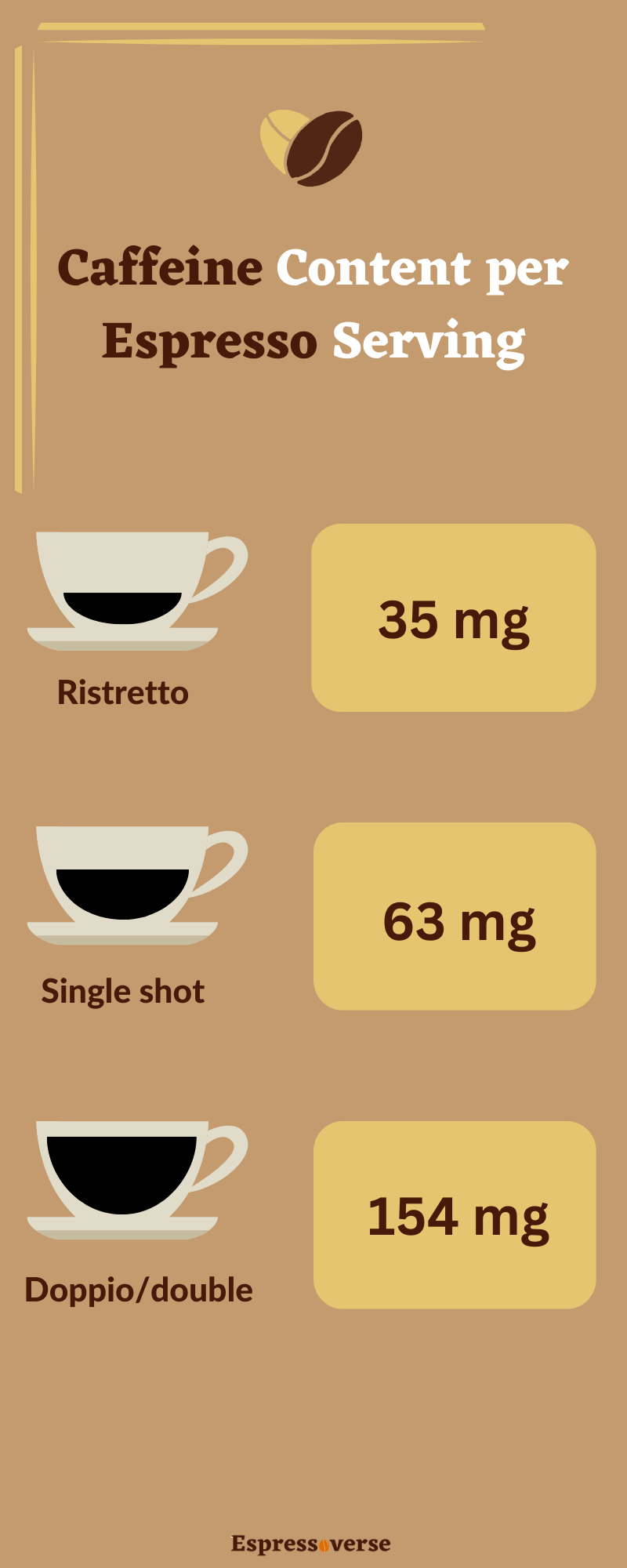
How Much Caffeine Is In a Shot of Espresso?
The amount of caffeine present in a single shot of espresso can vary significantly depending on how it is brewed and the type of beans being used.
Here is how much caffeine is in espresso, based on the serving size:
- Half shot/Ristretto = 35mg
- Single shot/Espresso = 63mg
- Double shot/Doppio = 154mg
PRO TIP: While this may seem like a particularly high level of caffeine when compared to other beverages, it is important to note that according to The Mayo Clinic, healthy adults should not consume more than 400 milligrams of caffeine per day.
How Does the Type of Bean Affect the Caffeine Content in Espresso?
The type of bean used to make an espresso can have a significant impact on the amount of caffeine contained in the drink.
For example, Arabica beans are generally known to have less caffeine than Robusta beans, but this is not always the case.
The percentage of caffeine contained in each bean type can vary depending on factors such as how much time it has been roasted or where it was grown.
Generally, Arabica beans tend to contain between 1.0%-1.5% caffeine whereas Robusta beans can contain between 1.7%-4.0% caffeine.
How Does the Roast Level Affect the Caffeine Content in Espresso?
The roast level of espresso beans can have a significant impact on the caffeine content.
On average, lighter roasts contain more caffeine than darker roasts, making them the ideal choice for those looking for an extra dose of energy.
However, this isn’t always the case and many other factors can influence the amount of caffeine present in espresso. I already talked about one factor. There is also grind size, brew method, etc.
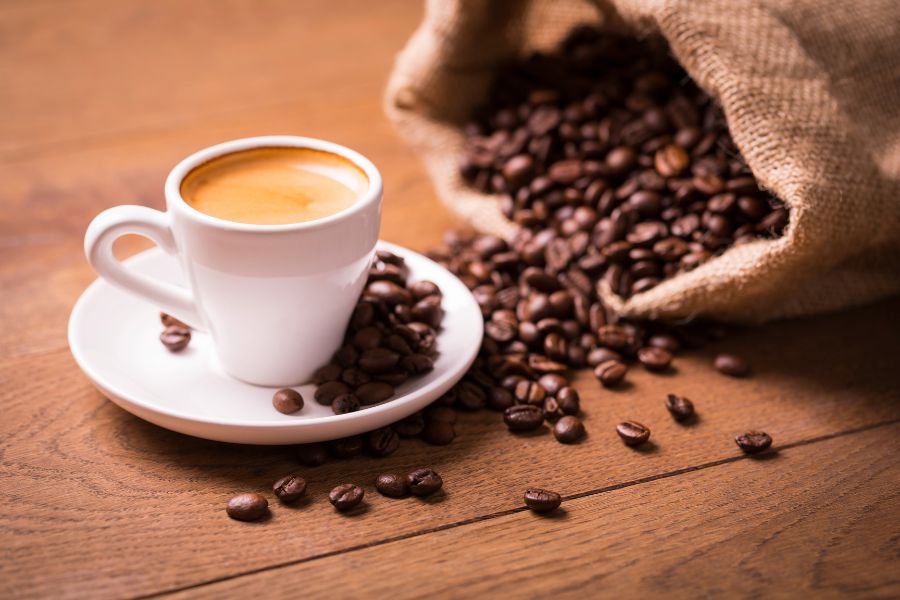
How Does the Grind Size Affect the Caffeine Content in Espresso?
Caffeine content is also affected by how finely the beans are ground before brewing espresso.
A finer grind will increase the surface area exposed to water during extraction, which results in a higher concentration of caffeine being extracted from the grounds into your cup of espresso.
PRO TIP: If you prefer a stronger coffee with more caffeine, you may want to go for a more finely milled grind size that is more suitable for espresso machines such as Turkish or espresso grinds instead of drip-coffee grinds like fine or medium-fine that are more suited for electric drip machines or pour-over cone brewers.
How Does the Brewing Method Affect the Caffeine in Espresso?
The length and intensity of brewing also affect the level of caffeine present in an espresso shot.
Shorter extraction times result in less dissolved solids and subsequently less caffeine while longer extraction times lead to more solubles being extracted into your cup resulting in higher levels of caffeine being present in your beverage.
PRO TIP: When making espresso, aim for around 18-22 seconds for a single shot and 30-35 seconds for a double shot to get the most out of your bean selection without extracting too much bitterness from it due to over-extractions from extended brew times.
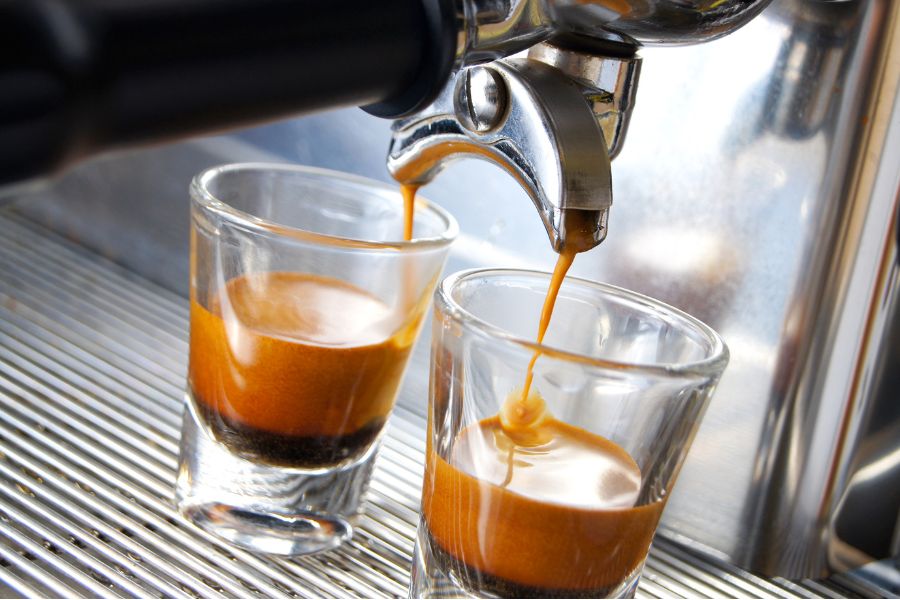
Tips for Reducing Caffeine Intake While Still Enjoying Espresso
Reducing caffeine intake while still enjoying espresso can be a challenge, but by understanding the effects of caffeine and making some adjustments to your consumption, you can enjoy espresso in a way that is healthy and still tastes great.
Here are some tips for reducing caffeine I apply when I overdo caffeine:
Drink Espresso Only In The Morning
Research suggests that the typical half-life of caffeine within a healthy body is 5 hours.
Therefore, if you were to consume a triple espresso shot at 5 PM, your body may not have enough time to process it, potentially resulting in several sleepless hours before morning.
Fortunately, it may be possible to avoid such issues by limiting yourself to one espresso shot or any other single-serving drink.
By taking this precautionary measure, you are sure to maintain the correct balance between alertness and restful sleep while still having to enjoy your shot of espresso every day.
Change the Way You Prepare Your Espresso
To reduce your caffeine intake while keeping the flavour intact, try using fewer espresso grounds when making your coffee beverages.
This will lower the amount of coffee in each serving while still providing a flavorful cup.
In addition, try drinking smaller servings of espresso at a time – opt for one shot instead of two or three shots if possible.
You may also want to avoid adding milk or cream to your espresso in order to further reduce its caffeine content. This is my go-to method for keeping my caffeine intake in balance.
Did you know there is a difference between coffee and espresso? This difference also affects caffeine levels too.
Experiment With Different Brewing Methods
If you want to reduce your caffeine intake while still enjoying espresso, a good idea is to try different brewing methods.
For example, if you use an Aeropress or French press then you can adjust the grind size accordingly which will result in lower levels of extracted caffeine from the beans.
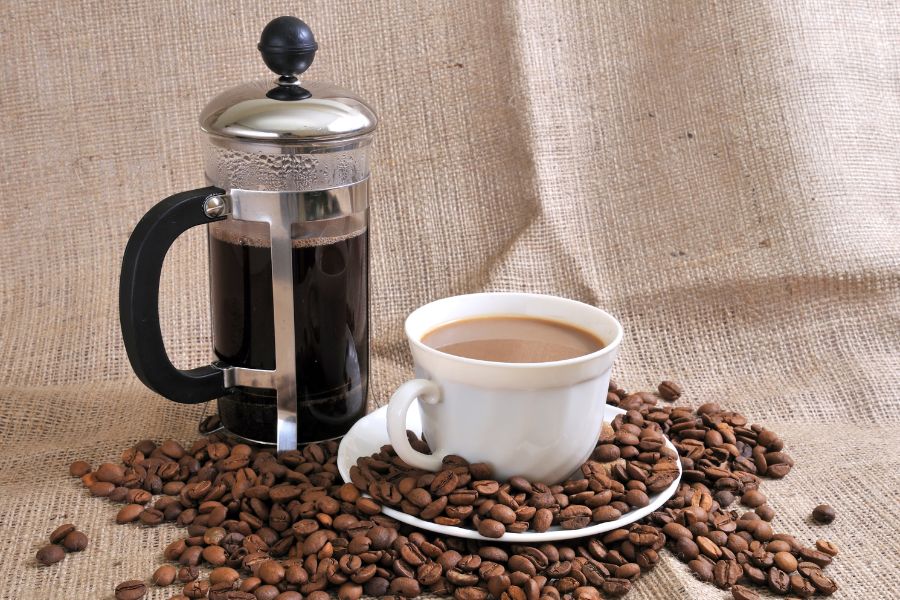
Experiment With the Type of Beans Used for Espresso
Different types of beans may have higher levels of naturally occurring caffeine than others.
If possible, opt for lighter roast beans as these tend to have less naturally occurring caffeine compared to darker roasts.
Additionally, try using organic beans as these may also contain less naturally occurring caffeine since organic farming practices are strictly regulated by law.
Drink Americano Instead of an Espresso
An Americano is made with a shot or two of espresso poured over hot water. Since it’s diluted with water, the amount of caffeine per cup is much lower than a regular shot of espresso (roughly 20-30 mg).
However, it should be noted that even though an americano contains less caffeine than regular espresso, it will still contain higher levels compared to other types of coffee beverages like filtered or cold brew coffee.
Switch to Decaffeinated Espresso
I know, I know. You don’t want to even hear this one but hear me out.
Decaf coffee contains very low levels of caffeine (typically 1-2 mg per shot). This will allow you to enjoy the flavour of espresso without having to worry about consuming too much caffeine.
There are many brands out there that specialize in producing decaf versions of espresso so finding one that works for you shouldn’t be too difficult.
Try Drinking Other Beverages in Place of Caffeinated Espressos
Try using herbal teas that have zero milligrams of caffeine per cup or switch to warm milk for a comforting and naturally sweet drink without any added stimulants like caffeine.
If you need something with a bit more flavour than just milk or tea alone, try making healthy smoothies with fruit and yoghurt or cocoa powder for additional sweetness and flavour without unnecessary levels of stimulants like caffeine.
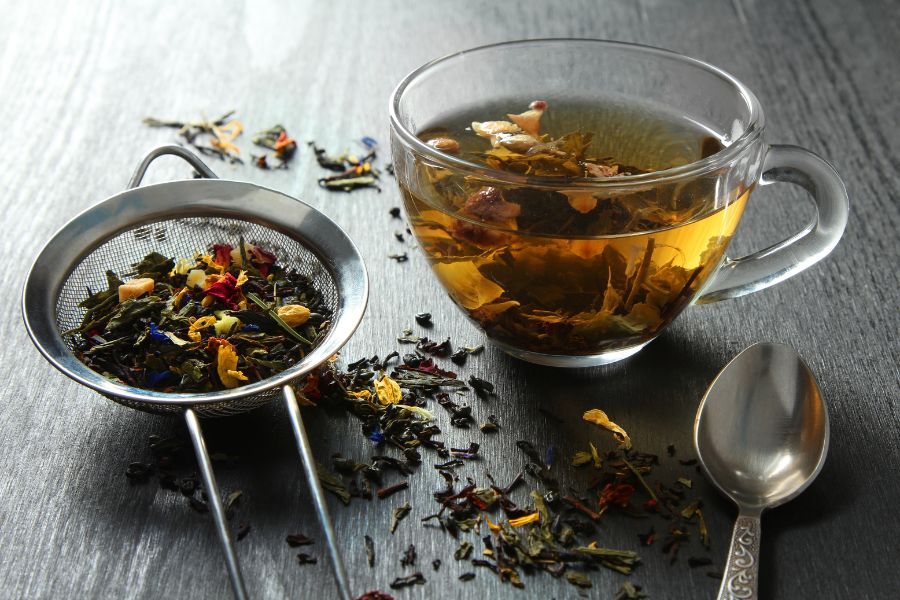
By following these tips for reducing your caffeine intake while still enjoying espresso, you can ensure that you get the most out of your coffee without having to worry about ingesting too much caffeine and potentially experiencing its unpleasant side effects.
Caffeine in Espresso FAQ
Is Espresso the Most Caffeinated Coffee Drink?
Espresso is certainly one of the most caffeinated coffee drinks out there, with typically 75-85mg per 2-ounce cup. However, it is not the only option for a potent dose of caffeine.
There are many speciality blends of coffee that contain higher amounts of caffeine than espresso shots.
How Long Does the Caffeine in Espresso Last?
While everyone’s experience may be slightly different, on average the effects of one shot of espresso usually linger for about 1-2 hours.
This means that depending on your individual body chemistry and tolerance, you may be feeling the energizing boost from your espresso even after two hours have gone by.
Can You Build Up a Tolerance to Caffeine in Espresso?
It is true that frequent espresso consumption can build up a tolerance to its caffeine content. The more you drink espresso over a long period of time, the more your body will recognize and adjust itself to it.
Is Decaf Espresso Completely Caffeine-Free?
In general, decaf espresso does have some caffeine present, although the levels are significantly reduced when compared to regular coffee.
Depending on the roasting bean and the amount used, there may still be anywhere from one to five milligrams of caffeine in each ounce.
Who Should Avoid espresso and Other Sources of Caffeine?
People who are sensitive to caffeine or lead an active lifestyle should be mindful of the amount of espresso and other sources of caffeine they consume.
Moreover, pregnant women and those with heart conditions should avoid consuming espresso and other caffeinated beverages.
What are the Effects of Caffeine on Sleep Quality and Quantity?
Research has found that caffeine can significantly reduce both the quality and duration of a person’s sleep, leading to increased fatigue throughout the day.
This fatigue can negatively impact alertness and cognitive functioning, as well as reduce productivity during waking hours.
Can Caffeine in Espresso Cause Anxiety?
Even though caffeine can provide energy and a mental boost, too much might also induce anxiety disorder. Studies have reported that consuming more than 400 milligrams of caffeine per day—roughly 4 cups of espresso—may cause irritability and other nervous symptoms.
How Does the Caffeine in Espresso Affect Athletic Performance?
The caffeine found in espresso has long been credited as an aid in athletic performance. Studies have shown that consuming caffeine prior to exercise increases focus and endurance.
Additionally, taking caffeine can result in increased adrenaline levels and improved muscle contraction, leading to improved explosive strength.
How Does the Caffeine in Espresso Affect Mental Performance?
The effects of this stimulant are thought to enhance mental performance and alertness by providing a surge of energy, improved concentration, and heightened focus.
According to recent scientific research, the amount of caffeine contained in espresso can help people improve their short-term memory formation, reaction time, speed in performing complex tasks, and alertness over long periods of time.
Conclusion
So there you have it, some of the most amazing facts about caffeine in espresso!
The next time you’re at your local coffee shop enjoying a delicious shot of espresso, you can impress your friends with all the knowledge you now have on this mighty little bean.
Just remember, espresso provides a quick and potent jolt of energy that can be helpful when you need to power through your day.
However, it’s important to remember that caffeine is a drug and should be consumed in moderation.
Too much caffeine can lead to side effects like anxiety and restlessness. Be sure to listen to your body and limit your intake accordingly. Thanks for reading!
What to Do Next?
I hope you enjoyed this post about the contents of caffeine in your shot of espresso. I have enjoyed preparing it for you.
Do you have any more questions about the topic? Let me know in the comments below!
Interested in learning more about espresso? My team and I invite you down to the rabbit hole. Check out our top espresso guides and keep on learning!
